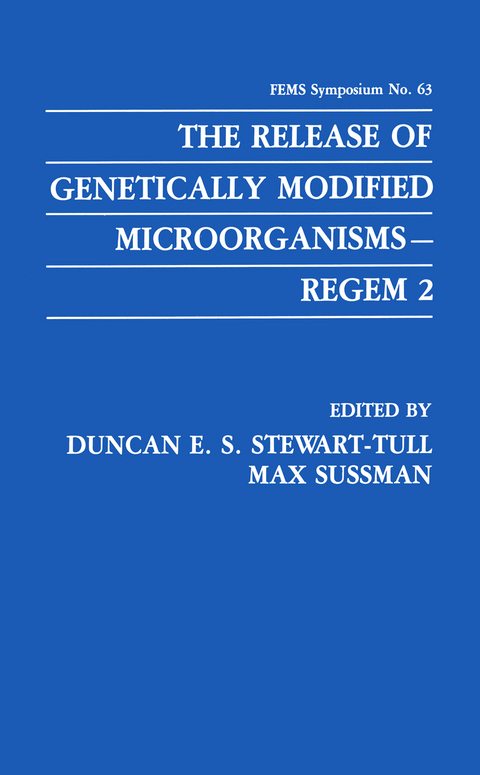
The Release of Genetically Modified Microorganisms—REGEM 2
Springer-Verlag New York Inc.
978-1-4612-7654-8 (ISBN)
If ripple effect is a measure of greatness in scientific discovery then GEMMOs have a lot going for them and this book dramatically illustrates the risks associated with advances being made by researchers to mobilize and control the power of the microorganism in the world's fight to perfect nature and fmd remedies for its imperfections. In the field of genetic science it is abundantly clear that so much more can be achieved through prevention rather than cure and that the indirect kill, by reason of its logic is a much more powerful weapon for winning results. Nevertheless the dilemma facing politicians arises over whether man should tamper with something which is God-given such as Radioactivity and Genetic endowment. The Roman Catholic church fmds difficulty in accepting the proposition that what is God given can be treated as a product under human control and maybe that is why recently half a century of genetic research on a strain of bees resistant to a devastating parasite at the Buckfastleigh Benedictine Monastery has inexplicably ceased whilst verging on scientific success.(l) The Anglican Community on the other hand does not see the sacrosanctity of Radioactivity and Genetic material as a bar to man-manipulation with appropriate safeguards.
Plenary Lectures.- Environmental Pressure Imposed on GEMMOs in Soil.- Interactions in Communities of Microorganisms.- Application of Genetically-modified Microorganisms in Agriculture.- Bioremediation and Waste Management.- Progress in the Genetic Modification and Field-release of Baculovirus Insecticides.- Exploitation of Genetically-modified Microorganisms in the Food Industry.- Live Attenuated Salmonellae: Oral Vaccines for Salmonellosis and Combined Vaccines Carrying Heterologous Antigens.- Commercial Use of Microbial Inocula Containing Live Genetically Modified Microorganisms (GEMMOs).- Risk Assessment.- Social Implications and Public Confidence: Risk Perception and Communication.- Workshops.- Workshop 1: Persistence and Survival of Genetically-Modified Microorganisms Released into the Environment.- Workshop 2: Detection Methods for Modified Organisms in the Environment.- Workshop 3: Environmental Impact.- Posters (Unrefereed).- Characterization of Microbial Emissions from a Fermentation Plant Using a Genetically-Modified Bacillus Strain.- Transfer of Inc.P and Inc.Q Plasmids in Soil and Filter Matings from Pseudomonas fluorescens to a Recipient Strain and to Indigenous Bacteria.- Impact of Introducing Genetically-Modified Microorganisms on Soil Microbial Community Diversity.- The Detection and Survival of Recombinant Pseudomonas putida Populations in Lake Water.- Survival of Introduced Bacteria in Rhizosphere and Non-Rhizosphere Soils.- Implementation of Pre-Tests for GEMMO Release in the Environment.- Plasmid Transfer and Stability of Pseudomonas cepacia and Enterobacter cloacae in a Continuous Flow Culture System.- Risk Assessment in Releases of Nitrogen-Fixing Enterobacter into Soil; Survival and Gene Transfer, as Influenced by Agricultural Substrates.- DirectDetection of E. agglomerans DNA Sequences in Soil.- The Survival of Microorganisms in the Open Air.- Survival and Dispersal of GEMMOs Associated with Animals.- Study of Intestinal Colonization with Norfloxacin In Vivo and In Vitro.- Studies on Gene Flux by Free Bacterial DNA in Soil, Sediment and Groundwater Aquifer.- Plasmid Transfer Between Pseudomonas aeruginosa Strains in Natural Soils.- Investigation of Possible Gene Transfer from Genetically Modified to Indigenous Bacteria in Soil.- Fate of Plant Pathogenic Pseudomonads in Bean Microcosms.- Detection of Streptomyces Marker Plasmids in Soil.- The Removal and Dispersal of Foliar Bacteria by Rain Splash.- Growth and Survival of Genetically-Modified Pseudomonas putida in Soils of Different Texture.- Simplified Subtraction-Hybridization System for Isolation of Strain-Specific Rhizobium DNA Probes.- Plasmid Transfer of pBR322 Derivatives from recA-E. coli K12 Donor Strain to Various Natural Gram-Negative Isolates.- Single Cell Detection of Bioluminescent Pseudomonas syringae in Soil.- Luminescence-Based Detection to Assess Survival and Activity of a Genetically-Modified Inoculum in Soil.- The Effect of Cyanobacterial Water Bloom Formation upon Conjugational Gene Transfer between Associated Heterotrophic Bacteria.- Construction and Detection of Bioluminescent Bacillus subtilis Strains.- Detection of Lux-Gene Sequences in Escherichia coli MM294 Extracted from Soil Using The Polymerase Chain Reaction and Gene Probing.- Monitoring Survival of Genetically-Modified Rhizobium in the Field.- Quantitative Detection of Genetically-Modified Microorganisms by the PCR-MPN Method.- Bioluminescent RECA Mutants of Rhizobium as Model Organisms in Risk Assessment Studies.- An Artificial Microcosm to Study Microbial Interactions in the Rhizosphere.- Detection of Bacteria from Natural Environments by Flow Cytometry.- The Detection of Bacteria in Aquatic Environments by Row Cytometry.- Bacillus thuringiensis as a Model Organism for Evaluating Risks of Release of GEMMOs.- Plasmid Mediated Resistance to Hexavalent Chromium in Agrobacterium.- Plasmid Transfer in Sterile Soil as Influenced by a Non-simultaneous Inoculation of Donor and Recipient.- Survival of Enterobacter cloacae on Leaves and in Soil Detected by Immunofluorescence Microscopy in Comparison with Selective Plating.- Genetic Manipulation of Rumen Bacteria.- Detecting Natural Transformation of Acinetobacter calcoaceticus, In Situ, Within Natural Epilithon of the River Taff.- The Survival of a Chloramphenicol Resistance Plasmid in a Natural Bacillus population.- Summary.- What Values in the GEMMOs? Reflections on REGEM 2.
| Reihe/Serie | F.E.M.S. Symposium Series ; 63 |
|---|---|
| Zusatzinfo | 286 p. |
| Verlagsort | New York, NY |
| Sprache | englisch |
| Maße | 170 x 244 mm |
| Themenwelt | Sachbuch/Ratgeber ► Natur / Technik ► Garten |
| Medizin / Pharmazie ► Medizinische Fachgebiete ► Mikrobiologie / Infektologie / Reisemedizin | |
| Naturwissenschaften ► Biologie ► Biochemie | |
| Naturwissenschaften ► Biologie ► Botanik | |
| Naturwissenschaften ► Biologie ► Mikrobiologie / Immunologie | |
| Naturwissenschaften ► Biologie ► Ökologie / Naturschutz | |
| Naturwissenschaften ► Biologie ► Zoologie | |
| Technik ► Umwelttechnik / Biotechnologie | |
| ISBN-10 | 1-4612-7654-3 / 1461276543 |
| ISBN-13 | 978-1-4612-7654-8 / 9781461276548 |
| Zustand | Neuware |
| Haben Sie eine Frage zum Produkt? |
aus dem Bereich


